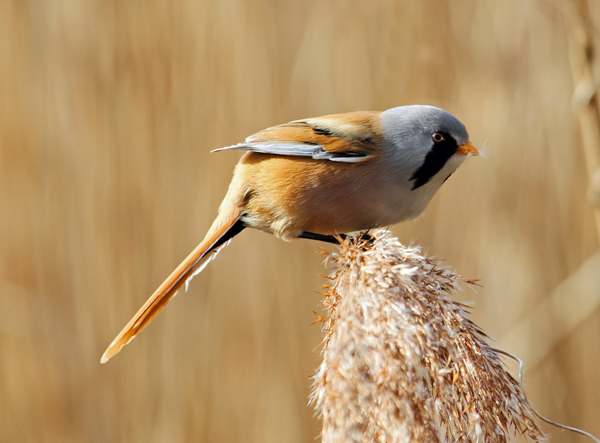Panurus biarmicus - Bearded Tit
Phylum: Chordata - Class: Aves - Order: Passeriformes - Family: Panuridae
Identification - Distribution - Lifecycle - Food - Predators - Reference Sources

Above: an adult male Bearded Tit
A lovely little bird, throughout the year the distinctive Bearded Tit inhabits large reedbeds where, despite its striking appearance, it can easily go unnoticed. Once thought to be related to other tits of the family Paridae, this species is now considered to be a closer relative of the various larks (family Alaudidae), but the differences are such that this species has been given a family all of its own, the Paruridae,
Description
Mostly cinnamon brown, with a long brown tail and a greyish head with a black moustache (not by any stretch of the imagination a beard!), the exotic-looking male is easily identified. Its eyes and bill are bright yellow. The female, in contrast, has duller plumage and does not have a moustache. These birds are typically 12 cm long and have a wingspan of approximately 17cm. The in-flight call of the Bearded Tit is a nasal 'ping' sound.
Distribution
Mostly resident in Britain (although sometimes there is a small influx from mainland Europe at the start of the breeding season), Bearded Tits are found southern and eastern England, and near Morecambe Bay in the northwest of England. In Scotland there is a significant breeding colony of these birds beside the Tay Estuary. Habitat creation and specialised nesting boxes have helped the Bearded Tit make something of a comeback in recent years. Cold winters with prolongued snow cover that makes seeds inaccessible as well as wet summers when water levels rise and nests become inundated can have a devastating impact on populations of Bearded Tits.
Feeding
Mainly reliant on iInsects during spring and summer, switching more to small reed seeds during autumn and winter, Bearded Tits find their food without leaving their reedbed habitat.
Breeding
The nests are built on piles of dead stems low down among standing reeds. These rather rare birds have up to four broods of young per year, comprising four to eight eggs each time.
Acknowledgements
This page includes pictures kindly contributed by Will Bown.
Please Help Us: If you have found this information interesting and useful, please consider helping to keep First Nature online by making a small donation towards the web hosting and internet costs.
Any donations over and above the essential running costs will help support the conservation work of Plantlife, the Rivers Trust and charitable botanic gardens - as do author royalties and publisher proceeds from books by Pat and Sue.

